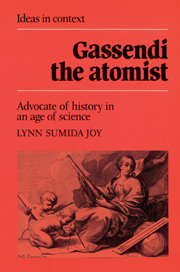Book contents
- Frontmatter
- Contents
- Preface
- List of illustrations
- INTRODUCTION
- PART 1 HUMANIST HISTORIOGRAPHY
- PART 2 PHYSICS AND THE HISTORY OF PHILOSOPHY
- 5 Unrecognized cultural baggage: the incoherence of contemporary debates about atoms
- 6 Uncertainties of observation and explanation: the role of optical anomalies in astronomy
- 7 Skepticism is based on bad history: Gassendi interprets Epicurus' arguments concerning the existence and qualities of atoms
- 8 Epicurus' conception of proof and Gassendi's historical justification of an atomist metaphysics and physics
- 9 Between culture and nature: was Gassendi a historian, a scientist, an empiricist?
- List of abbreviations used in the notes
- Notes
- Index of names
6 - Uncertainties of observation and explanation: the role of optical anomalies in astronomy
Published online by Cambridge University Press: 01 September 2009
- Frontmatter
- Contents
- Preface
- List of illustrations
- INTRODUCTION
- PART 1 HUMANIST HISTORIOGRAPHY
- PART 2 PHYSICS AND THE HISTORY OF PHILOSOPHY
- 5 Unrecognized cultural baggage: the incoherence of contemporary debates about atoms
- 6 Uncertainties of observation and explanation: the role of optical anomalies in astronomy
- 7 Skepticism is based on bad history: Gassendi interprets Epicurus' arguments concerning the existence and qualities of atoms
- 8 Epicurus' conception of proof and Gassendi's historical justification of an atomist metaphysics and physics
- 9 Between culture and nature: was Gassendi a historian, a scientist, an empiricist?
- List of abbreviations used in the notes
- Notes
- Index of names
Summary
The discussion of the nature of atoms which grew out of Poysson's problem suggested to Gassendi that physical atomism would be an indispensable key to the future development of physics. However, this relatively brief scholarly exchange was one among many similar exchanges in which Gassendi had observed that incompatible definitions of concepts and incommensurable rival solutions to the problems at hand had rendered the exchanges incoherent. The ambiguities which characterized Poysson's problem were also endemic to the interpretation of several major scientific investigations in astronomy and optics which Gassendi undertook during the 1630s and 1640s. Even when these investigations were based on a specific set of observations or experiments, at least four sorts of disagreements usually arose in the subsequent scholarly exchange. (1) Different observers could not always agree about what exactly they saw when they observed celestial phenomena through a telescope or when they made naked-eye observations, for example, of the apparent magnitude of the sun at different elevations above the horizon. (2) Their explanations of what they saw were often expressed in terms of widely divergent optical theories about the constitution and behavior of light.
- Type
- Chapter
- Information
- Gassendi the AtomistAdvocate of History in an Age of Science, pp. 106 - 129Publisher: Cambridge University PressPrint publication year: 1988



